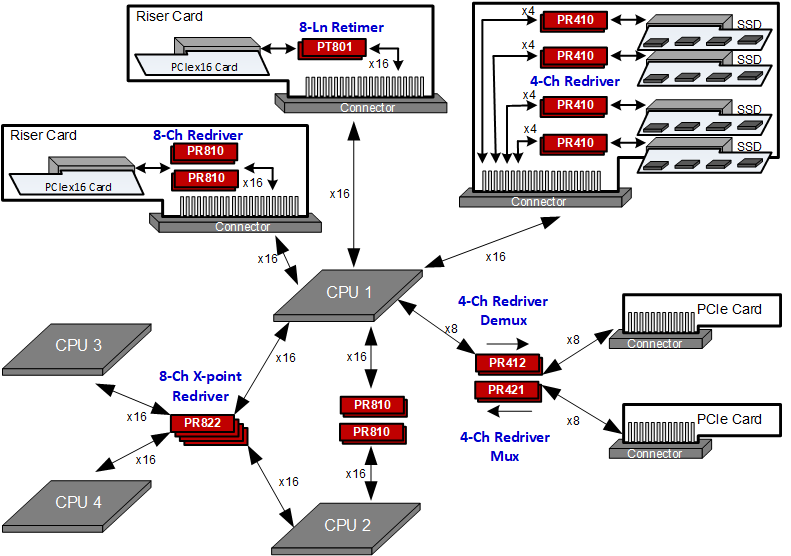SNLA388 June 2021 DS160PR410
2.3 PCIe Interface
A PCI Express interface is an efficient way to transfer high bandwidth data between different elements in a system such as in between CPUs, CPU to add on functions (End Points) and CPU to storage devices. While the interface is the main backbone of bulk data transfer for PC and server applications today, its use is diverse and includes industrial applications. With increasing need for large data handling and transport within industrial PCs, test equipment, factory automation, IOTs, the popularity of PCIe is growing.
A PCIe link can be within a single PCB or through cables or across a back plane. A PCIe link can be of different data rates up to 32 Gbps PCIe 5.0. Loss profile of the electrical link and its speed will determine signal integrity fidelity. Recommended loss budget for a PCIe 4.0/5.0 link is maximum 28/36 dB respectively. Often real implementation suffers from impairments such as non-ideal transmission lines, discontinuity of different elements of the channel, cross talk etc. that decreases the link reach from ideal loss budget. Furthermore, many system implementations require reach extensions to be able to go further. To increase signal reach and or improve signal integrity fidelity there are likely three choices each with its tradeoffs:
- low loss board material - increases board cost significantly,
- linear redriver – good fit in systems where eye masks fail due to excessive deterministic jitter (DJ) from additional channel loss, and
- protocol aware retimer – good fit for systems with too much loss or un-equalizable loss such as crosstalk, reflections, skew and random jitter.
Depending on application use case, signal integrity situation and other factors signal conditioning can be achieved by a linear redriver or retimer. Linear redrivers such as DS160PR810 and DS160PR410 are simple components that helps with insertion loss. They are typically low power, low cost, low latency options. However, linear redrivers have limited capability compared to retimers. Linear redrivers are an excellent choice where the main objective is to offset for some additional channel loss. On the other hand retimers such as DS160PT801 are more potent signal conditioners that can address link impairments such as insertion loss, jitter, crosstalk, reflections & skew. However the added benefit comes with increased price tag and additional complexity and power consumption.
Depending on actual topology and PCIe link bus width, the system implementation may require linear redriver or retimer of various configuration that include unidirectional, bidirectional, multiplexer, demultiplexer and cross point mux devices. Figure 2-6 outlines various such options for 16 Gbps PCIe 4.0.
 Figure 2-6 PCIe 4.0 Signal Conditioner
Functions Using TI Redriver and Retimers
Figure 2-6 PCIe 4.0 Signal Conditioner
Functions Using TI Redriver and RetimersIn addition to PCIe-compliant retimers and redrivers, clock buffers are often used in industrial system implementations. Clock buffers such as LMK00334 , LMK00338, and clock generators, such as CDCE6214 and CDCM6208 can help to achieve end-to-end PCIe-compliance for PCIe links.